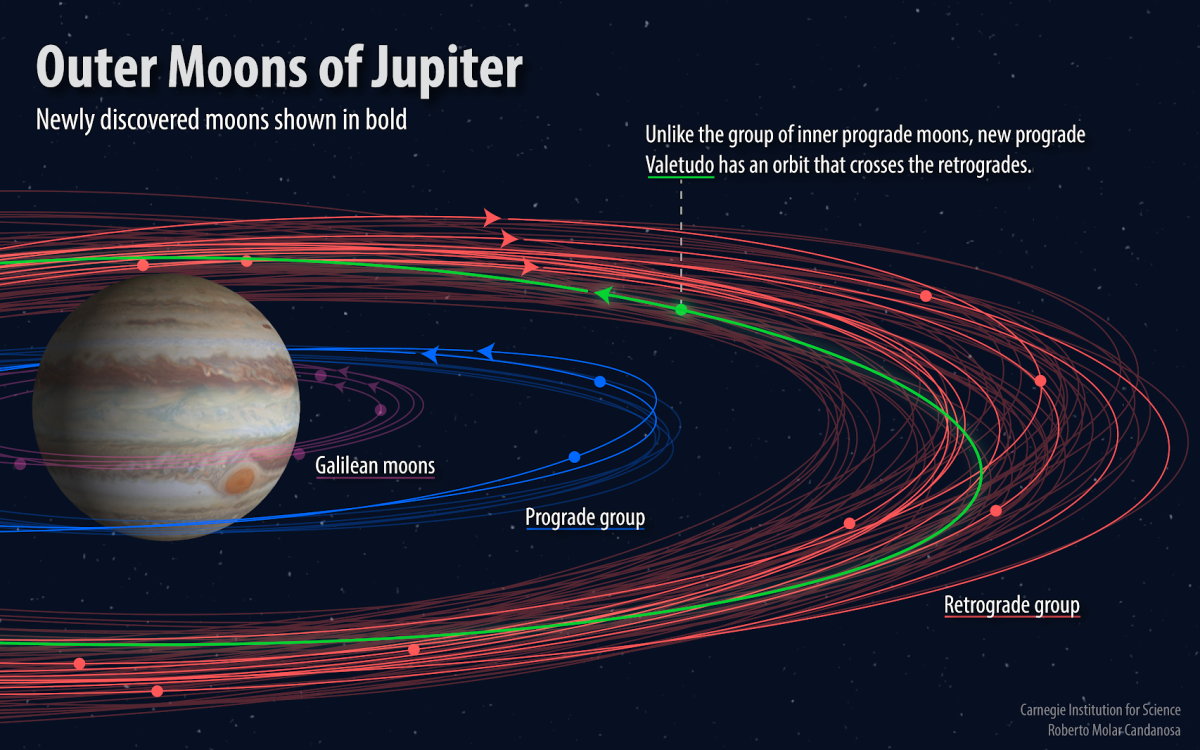Scientists discover 12 new moons orbiting Jupiter while hunting for the elusive Planet X

Scientists discovered 12 new moons of Jupiter discovered, including one “oddball.”
While hunting for the elusive Planet X, astronomers have discovered 12 additional moons around Jupiter, bringing the grand total of the planet’s known satellites up to a whopping 79.
The new moons are all relatively small — between 1 and 3 kilometers (.6 to 1.8 miles) across, which is likely why they haven’t been spotted before, scientists said.
They were first seen in the spring of 2017 by researchers who have spent the last few years searching for Planet X, also known as Planet 9 — an object they expect to be Mars-sized or bigger.
They believe it lies in the distant solar system, as much as 100 times farther from the sun than is the Earth. (For reference, Pluto is about 30 times farther from the sun than Earth is).
Any object that far away will receive very little light from the sun that it can reflect back to telescopes on Earth, which is why the search has been so challenging, said Scott Sheppard, an astronomer at the Carnegie Institution for Science in Washington who led the work.
To aid them on this quest, the science team is using a four-meter telescope in Chile attached to the largest camera ever built.
It’s called the Dark Energy Camera, and it’s about the size of a smart car, Sheppard said.
Because the camera is so big, it can capture a much wider patch of sky in a single exposure than was previously possible.
“It allows us to be much more efficient than we’ve been in the past,” Sheppard said. “It used to be that one image was basically the area of a full moon in the night sky. Now we can cover twelve times that much.”
Sheppard and his colleagues are primarily focused on surveying the deep outer solar system, but a few years ago they realized that the Jupiter system was well positioned for them to take a closer look at its myriad satellites.
“It was kind of like trying to kill two birds with one stone,” Sheppard said. “We thought we might find a few more moons by covering the whole Jovian system in one exposure, which hadn’t been done before.”
The researchers deliberately picked fields to image that would allow them to see Jupiter’s moons without the bright light from the planet itself getting in the way.
They were able to determine which points of light in their images were Jovian moons because they moved across the sky at the same rate as their host planet.
“Anything that moved much slower would be a more distant object,” Sheppard said.
Their observations revealed the 12 never-before-seen moons. Eleven of them have been verified by representatives of the International Astronomical Union’s Minor Planet Center. The status of the 12th moon is still pending, although the researchers expect that it will be verified soon.
Most of the newly discovered moons belong to two previously known families of satellites.
Nine of them circle Jupiter in a wide, retrograde orbit, which means they move in the opposite direction that the planet rotates. It takes them about two Earth years to orbit Jupiter.
Two of them are part of a more inner group of moons that circle the planet in the prograde, or the same direction as it spins. This group completes a single orbit around Jupiter in one Earth year.
However, there is one moon, tentatively called Valetudo, that stands out. It doesn’t belong to any known group of moons, and it follows a strange prograde orbit that occasionally crosses the path of the retrograde moons.
“It’s basically going the wrong direction on the highway,” Sheppard said. “And that means that the chances of a collision are much higher.”

Sheppard said the discovery of Valetudo could help answer some longstanding questions about the formation of the extensive Jovian system.
Scientists believe that the families of small moons we see orbiting Jupiter today may have once been single, larger moons that broke apart after colliding with something — perhaps an asteroid or comet.
But if Valetudo is the remnant of a much larger moon with the same weird orbit, it is possible that the families of small moons were created by the collision of two moons.
Sheppard added that the team is currently running a simulation using supercomputers to determine how long before Valetudo crashes into one of the moons in the retrograde orbit. He expects that it will be sometime between 100 million and 1 billion years.
“The chances of us seeing an impact in any one year is vanishingly small, but it is likely in the life of the solar system,” said Gareth Williams, an astronomer at the Harvard Smithsonian Center for Astrophysics, who determined the orbits of the newly discovered moons for the International Astronomical Union.
Williams said he was not surprised by Sheppard’s discovery of additional moons around Jupiter.
“We know there are probably hundreds of moons around Jupiter that are a kilometer or more in diameter at the moment,” he said.
However, he said the finding is still significant.
“Knowing how many satellites around each of the planets is important because any formation scenario for the planet has to account for the satellite system,” he said. “If your model only accounts for 20 satellites, that’s not going to fly when you suddenly have 60.”
He added that now that these moons have been discovered, and their orbits determined, scientists will know where to point their telescopes in order to study them more in depth. That will help them determine how dark they are and what they are made of, helping researchers learn more about the makeup of our solar system.
In the meantime, Sheppard’s hunt for Planet X continues. Who knows what else he and his colleagues might discover along the way?
Do you love science? I do! Follow me @DeborahNetburn and “like” Los Angeles Times Science & Health on Facebook.







